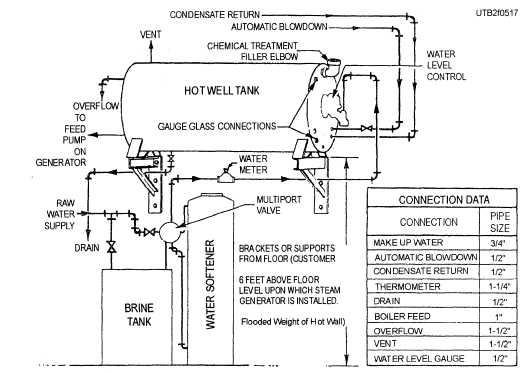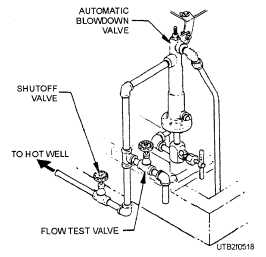Home > Construction Training Manuals > Utilitiesman Basic Volume 02 > Preventive Maintenance And Repair

Figure 5-17. - A typical installation of horizontal hot-well tank and connection data.
allows the release of steam to permit the steam generator to operate under full load when adjustments are made.
Connect the pipe accumulator blowdown valve and coil drain valve to waste. These lines may be manifolded into a common line of not less than l-inch-diameter pipe. Connect the pipe discharge from the steam safety valve to the atmosphere. You should provide a 1/4-inch-diameter (minimum) pipe drain at the lowest point in the safety valve vent line piping.
The pipe outlet from the accumulator steam trap should be connected to the condensate return connection on the hot well with 3/4-inch- diameter pipe.
To permit periodic checking of the automatic blowdown valve adjustment, you should install a shutoff valve and a flow test valve, as shown in figure 5-18. Pipe the discharge from the shutoff valve to the automatic blowdown connection on the hot well.
Make electrical connections to terminals in the electrical control box. Install a disconnect switch in the line next to the steam generator to ease the isolation of electrical components from the line if service is necessary. Start the motor momentarily to check rotation. Rotation should be clockwise as viewed from the front of the plant.
Preventive Maintenance and Repair
Like any piece of mechanical equipment, the steam generator requires proper maintenance and some repairs will be needed to maintain the efficiency and service it is designed to provide. The following discussion covers some of the maintenance and repair requirements for the Clayton steam generator, Model RO-33-PL. For detailed information on the maintenance and upkeep of this and other types of

Figure 5-18. - Suggested automatic blowdown valve discharge piping.
Continue Reading